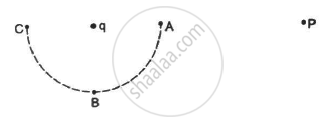Advertisements
Advertisements
प्रश्न
Consider a system of n charges q1, q2, ... qn with position vectors `vecr_1,vecr_2,vecr_3,...... vecr_n`relative to some origin 'O'. Deduce the expression for the net electric field`vec E` at a point P with position vector `vecr_p,`due to this system of charges.
उत्तर
Let us consider a system of n charges q1, q2, ... qn with position vectors r1, r2, r3, ...rn relative to origin O.

Let `vecF_i` be the force due to ith charge qi on q0.
Then,
`vecF_i = 1/(4πε_0) (q_1q_0)/(r_i^2) \ hat r_i`
Here, ri is the distance of the test charge q0 from qi.
The electric field at the observation point P is given by `vecE_i = lim_(q0->0) vecF_i/(q_0) = lim _(q0->0) 1/q_0 (1/(4πε_0) (q_1q_0)/r_1^2 hatr_i)`
`vecE_i = 1/(4πε_0) q_i/(r_1^2)hat r_i ........ (1) `
If `vecE` is the electric field at point P due to the system of charges, then by the principle of superposition of electric fields,
`vecE = vecE_1 +vecE_2 +vecE_3 +....vecE_n = sum_(i=1)^n vecE_i`
Using (1), we get
`vecE = sum_(i=1)^n 1/(4πε_0)q_i/(r_i^2)hat r_i `
`vecE =1/(4πε_0) sum_(i=1)^n q_i/(r_i^2)hat r_i`
APPEARS IN
संबंधित प्रश्न
The figure shows tracks of three charged particles in a uniform electrostatic field. Give the signs of the three charges. Which particle has the highest charge to mass ratio?

An infinite line charge produces a field of 9 × 104 N/C at a distance of 2 cm. Calculate the linear charge density.
The charge on a proton is +1.6 × 10−19 C and that on an electron is −1.6 × 10−19 C. Does it mean that the electron has 3.2 × 10−19 C less charge than the proton?
Consider the situation in the figure. The work done in taking a point charge from P to Ais WA, from P to B is WB and from P to C is WC.

A point charge q is rotated along a circle in an electric field generated by another point charge Q. The work done by the electric field on the rotating charge in one complete revolution is
The electric field and the electric potential at a point are E and V, respectively.
12 J of work has to be done against an existing electric field to take a charge of 0.01 C from A to B. How much is the potential difference VB − VA?
An electric field of 20 NC−1 exists along the x-axis in space. Calculate the potential difference VB − VA where the points A and B are
(a) A = (0, 0); B = (4 m, 2m)
(b) A = (4 m, 2 m); B = (6 m, 5 m)
(c) A = (0, 0); B = (6 m, 5 m)
Do you find any relation between the answers of parts (a), (b) and (c)?
The surface charge density of a thin charged disc of radius R is σ. The value of the electric field at the center of the disc is `sigma/(2∈_0)`. With respect to the field at the center, the electric field along the axis at a distance R from the center of the disc ______.
Two similar spheres having +Q and -Q charges are kept at a certain distance. F force acts between the two. If at the middle of two spheres, another similar sphere having +Q charge is kept, then it experiences a force in magnitude and direction as ______.
